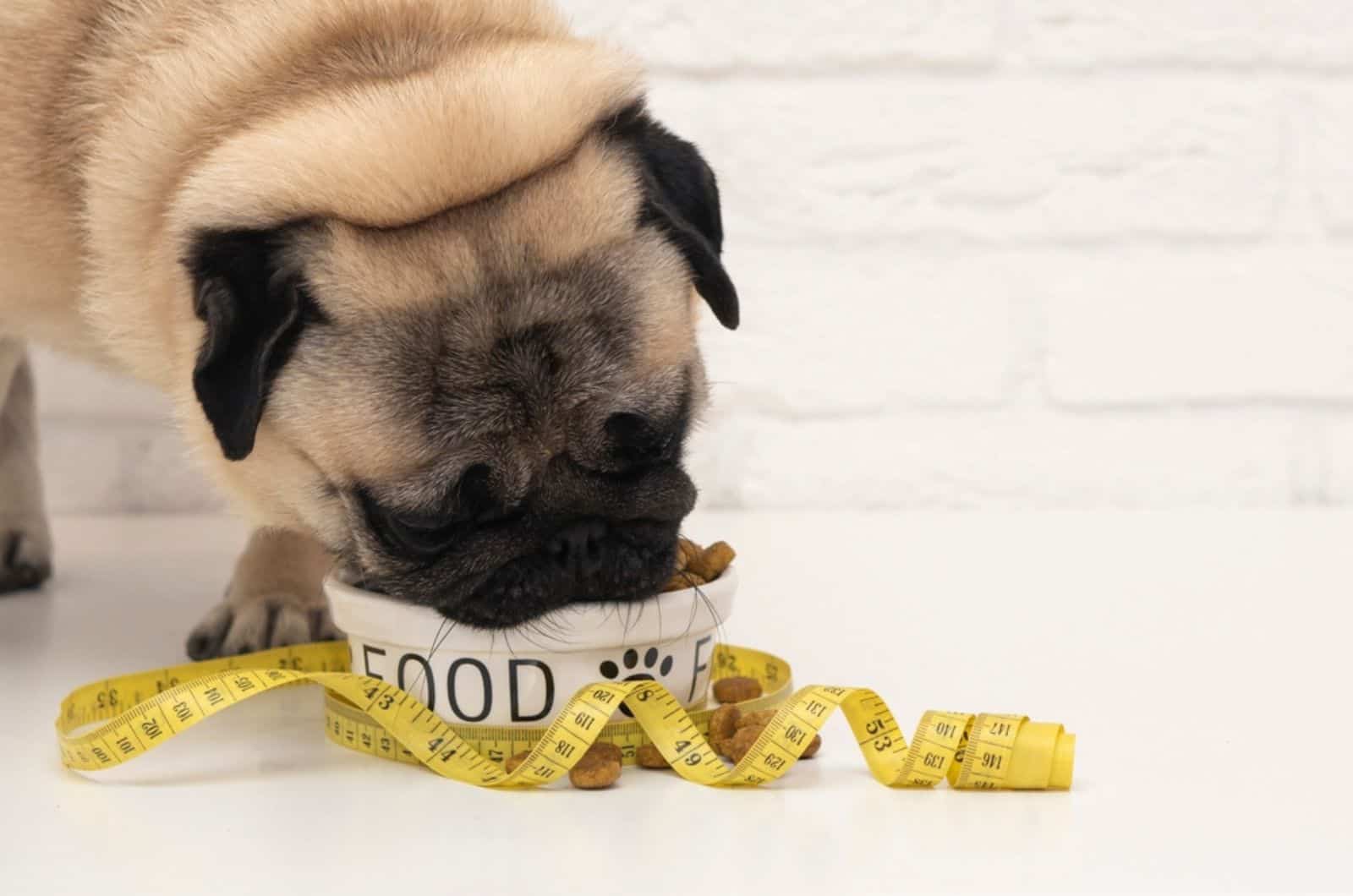Millions of fans throughout the world now adore the small but sturdy Pug. It was once the companion of Chinese emperors and later served as the mascot of Holland’s royal House of Orange. Pugs are creatures of love and devotion.
If you are a current or a prospective Pug owner, the Pug growth chart will definitely be something you are interested in. This handy little tool allows you to predict your pet’s size and prepare accordingly.
Pugs have large round heads, big, sparkling eyes, and wrinkled brows, which have charmed pet owners for generations. They like living in the city or the country, with young children or senior citizens, as a single pet or as part of a pack. They enjoy eating, but it’s important to keep them in shape.
With the help of this Pug growth chart, you will know exactly how much they should weigh and how you can help them stay within those healthy parameters.
Pug Growth Chart
[table id=656 /]
About The Pug Breed
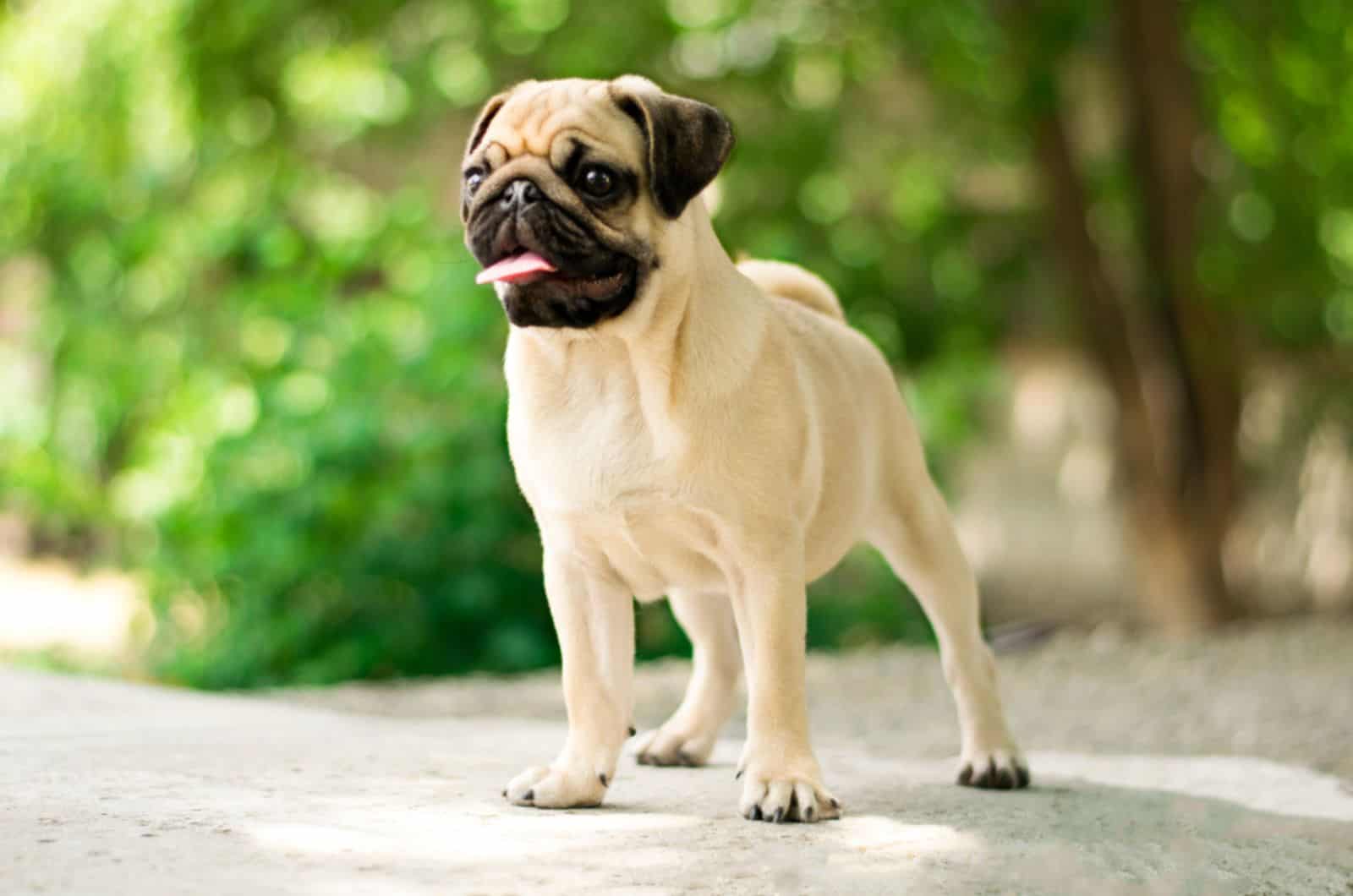
The Pug is frequently referred to as “a lot of dog in a small body.” These robust, little dogs, which belong to the American Kennel Club’s toy group of breeds, are renowned as the clowns of the canine world for their sense of humor and all-around goofiness.
They most frequently come in black and fawn, but there are other Pug colors, as well.
Pugs, who were originally designed to be lap dogs, enjoy being around people. They are quite sensitive, and while they can make wonderful apartment pets, they won’t like spending a lot of time alone at home.
These puppies are playful, affectionate dogs who will get along with even inexperienced pet parents, despite having a stubborn side, especially when it comes to housetraining. This breed might be the one for you if you’re seeking for a kind, laid-back friend!
Pugs were first domesticated in China during the Han era (B.C. 206 to A.D. 200). According to some historians, they are descended from the Tibetan Mastiffs. They don’t really look alike though, do they?
The Chinese Emperors treasured them, and they lived in lavish homes, occasionally even with troops on duty to protect them.
Pugs were brought to the United States just after the Civil War, and the American Kennel Club officially recognized them as a breed in 1885. Pugs were initially quite well-liked, but by the turn of the century, sentiment had changed.
A few devoted breeders persisted in breeding them, and after a while, the breed’s popularity returned. The Pug Dog Club of America was established in 1931 and received AKC approval in the same year.
A Pug’s Life: The Development Stages Of A Pug
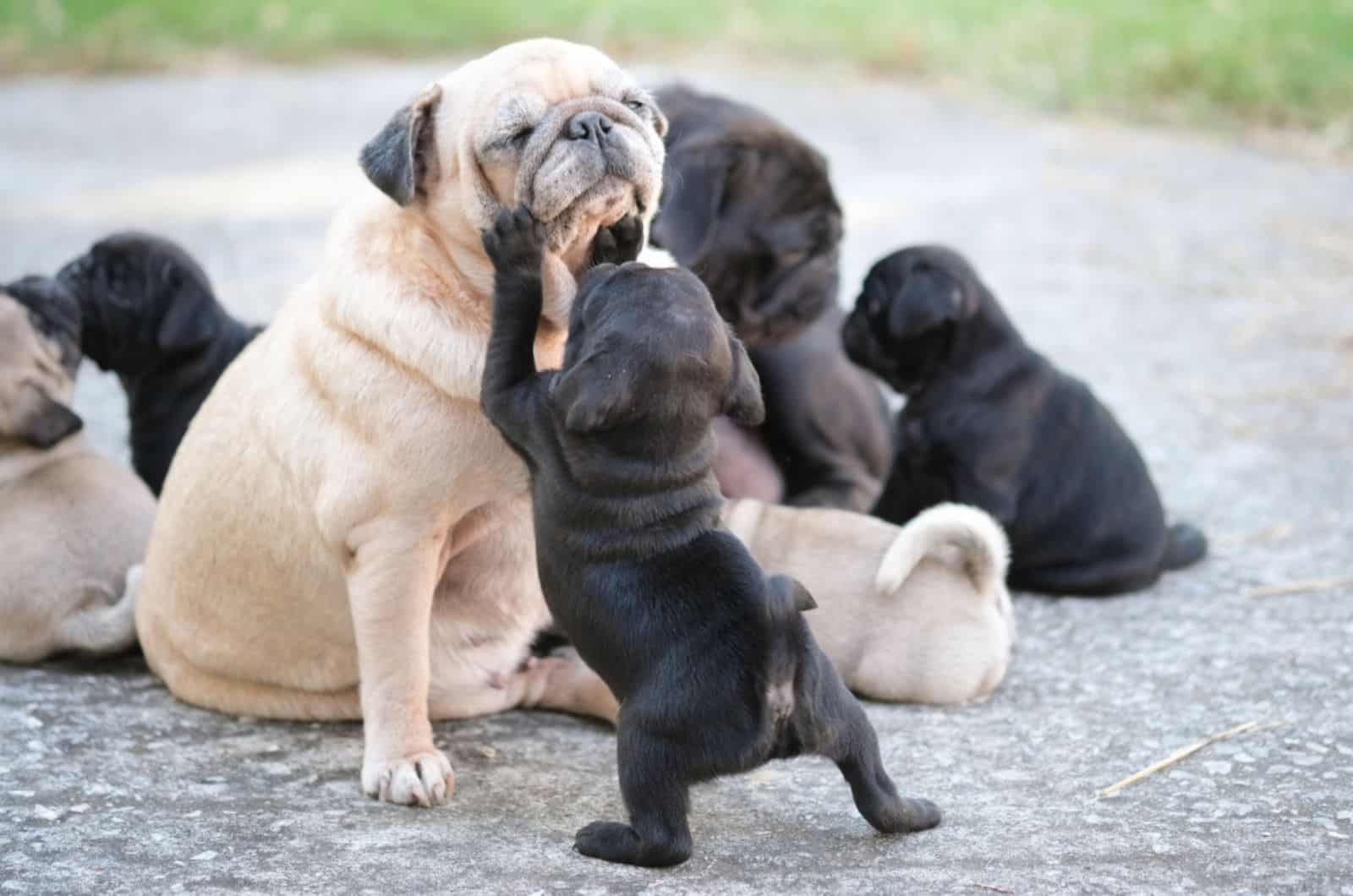
As you can see from the puppy weight chart — and as you’ve probably already known — Pugs are tiny little creatures. But even in those small bodies, a lot of stuff can be happening.
Pugs go through a lot of physical and mental changes during the first year of their life. Their development is pretty rapid and they can sometimes reach full adult size at just nine months of age.
But what exactly happens in those months? And how do Pug puppies behave in certain periods?
Those are the questions that we’ve tried to answer in the following segment. We’ve divided the Pugs’ puppyhood into several distinct developmental stages and we will talk about each of them separately.
From Birth To Two Weeks
Pugs are a petite breed, so at birth, they won’t weigh much, but by about a week their weight should have doubled. You should probably expect about a 5% daily weight gain from them.
Puppies will be toothless, blind, and deaf at this age, but they will have a sense of taste and touch. Thanks to a lifestyle consisting of exclusively nursing and napping, they will develop and grow swiftly.
From Two Weeks To Three Months
This marks the start of a transitional stage in the Pug’s puppyhood, which is a period where they go through a lot of changes.
Your pug puppies should perk up and start to interact more by the time they are three weeks old. They’ll have more fun and explore more. They should be able to get out of bed and go potty on their own, since they will start to have some control over their bladder.
By the time they are eight weeks old, they can start some proper house training, and by nine weeks, they can start learning basic commands.
When it comes to their size, they should already weigh around six pounds by this point.
From Three Months To Six Months
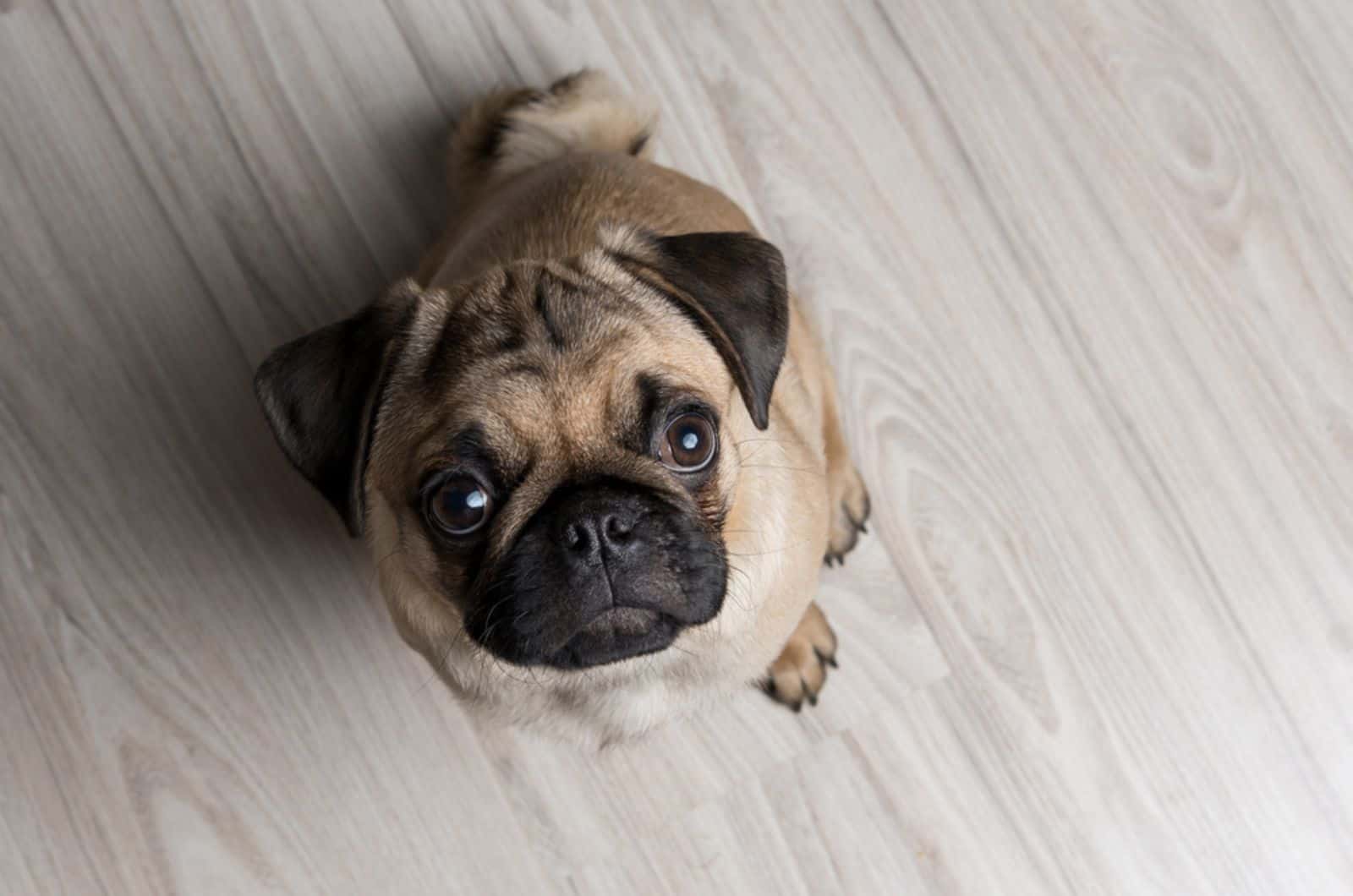
Your pug might weigh anywhere from five to eight pounds by the time it’s four months old. When teething begins, you’ll notice that your puppy has already begun chewing on anything he can get his mouth on. This indicates that your puppy will be losing teeth as well.
To avoid your puppy being destructive, it’s crucial to keep safe, chewable toys nearby. Pugs aren’t aggressive by nature, but they can get agitated sometimes.
A 6-month-old pug will closely resemble a full-grown adult in its physique, but the development process is not yet quite over.
From Six Months To Nine Months
Your pug should be approaching adult size by the time he is nine months old. It should already weigh close to 18 pounds, but keep in mind that some dogs are slightly bigger or smaller than others.
By now, your puppy should have finished teething. To help maintain your puppy as healthy as possible, you must keep him active and stimulated.
From Nine Months To One Year
Most Pugs are fully physically formed and close to their full adult weight by the time they are nine months old. However, some of them can still continue to add a little bit of weight past this mark.
While that is completely okay — some Pugs are bigger than others — you should keep an eye on it and make sure it doesn’t get overweight.
Offer plenty of opportunity for exercise, because Pugs like being active, and due to their unique physical build, they need to stay as slim as possible.
Adult Pug
Pugs are generally considered fully adult after nine months of age, although some of them won’t completely mature until they are twelve months old. The true prime of a Pug’s life starts when they are one year old, and ends after they turn seven, after which they are considered senior dogs.
The eventual weight of an adult pug will be strongly influenced by his gender, the quantity of exercise it gets, and the kind of food it consumes.
Nevertheless, the weight of an adult pug can range from 14 to over 18 pounds. You should check with your veterinarian to make sure your pug is a healthy weight if it weighs more than 22 pounds because that’s the point where it becomes too much.
Being little dogs, even a few pounds make a difference.
What Determines The Size Of A Pug?
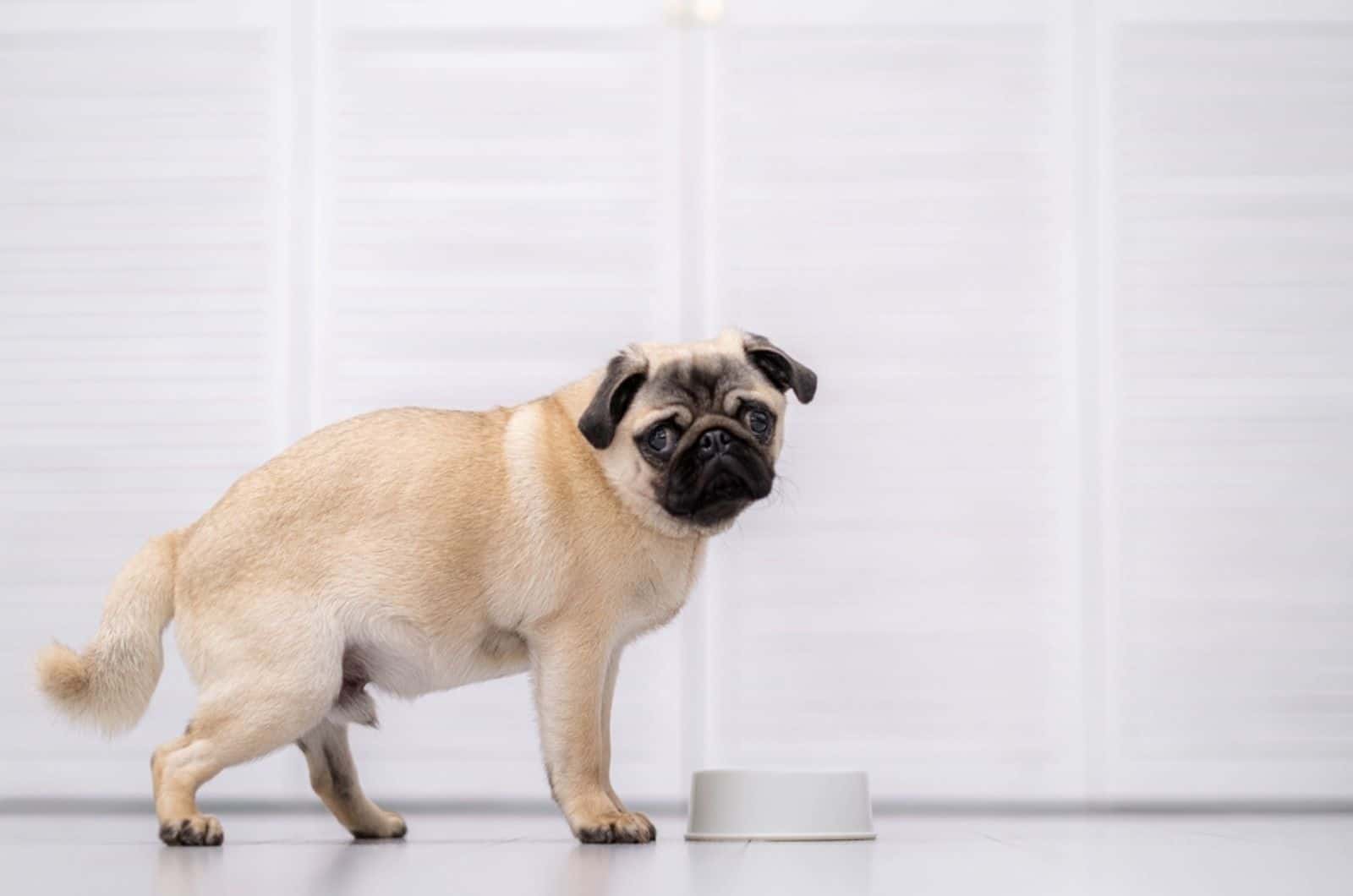
There is a basic average range associated with the breed, but not every Pug will end up being the same height and weight.
Furthermore, the weight chart that we provided is mostly referential for standard-size Pugs and not taking into account the special case of teacup Pugs.
This is due to the fact that it is hard to anticipate the growth of the puppies to within an inch or pound because there are so many diverse elements that in the end determine their development.
You may even be able to have some degree of control over your puppy’s growth if you have a better understanding of what the most important factors are. In other instances, it may even enable you to identify early signs of anomalies or health problems.
We can roughly divide those factors into two distinct categories: internal and external.
Internal Factors
Internal factors that impact the growth of a Pug are those that are embedded within the dog as soon as, or even before, it is born.
This is what nature has given the pup, and there is nothing you can do to change or influence it. However, knowing these details and the effect they have on puppy development can help you prepare and anticipate certain things.
The two biggest internal elements that shape the growth of a Pug are its genetic makeup and its gender.
Genetics
The height and tendency to gain weight of your pug can be influenced by genetics. Pugs could exercise frequently, just like people, yet still, gain weight.
Your dog will naturally be smaller if he is the runt of the litter. Your puppy’s growth may also be impacted by specific inherited health issues.
Gender
Because they are such a small breed, there isn’t really enough space for truly visible physical differences between male and female Pugs. However, that doesn’t mean that there aren’t any.
Male pugs stand between ten and thirteen inches tall and weigh between 14 and 18 pounds, while females are slightly smaller, with their average height being twelve inches, and the average weight between 13 and 16 pounds.
Although that doesn’t seem like much, it actually results in female pugs being slimmer, less stocky, and less muscular than male pugs.
External Factors
Outside of nature-given, genetic factors, there are also those that are the result of the Pug’s living environment.
These external factors are something that you have full control over, and you can use them to maintain your Pug’s weight within the healthy parameters.
As you might have guessed, the two biggest external factors in determining the growth of a Pug are nutrition and exercise.
Nutrition
In terms of your dog’s weight, nutrition plays a major role. There are a lot of different dog foods out there, and some of them contain fillers or additives that are actually unhealthy for Pugs to consume.
Your dog has to be fed multiple times per day, but be mindful of the type and the amount of food. Meat ought to be the first component of a dog’s meal, but it should be supplemented by various other protein, fat, vitamin, and mineral sources.
Physical Activity
Your pug’s physical activity and health are the last two factors that will have an impact on his weight. Pugs may not be the most active dogs, but they still need enough walks, play and exercise to stay healthy.
They are probably lighter as they move more. Their general health will improve, which is crucial for growing puppies. In order to be healthy, your puppy also has to receive vaccinations and be fed consistently.
Pug Health Problems
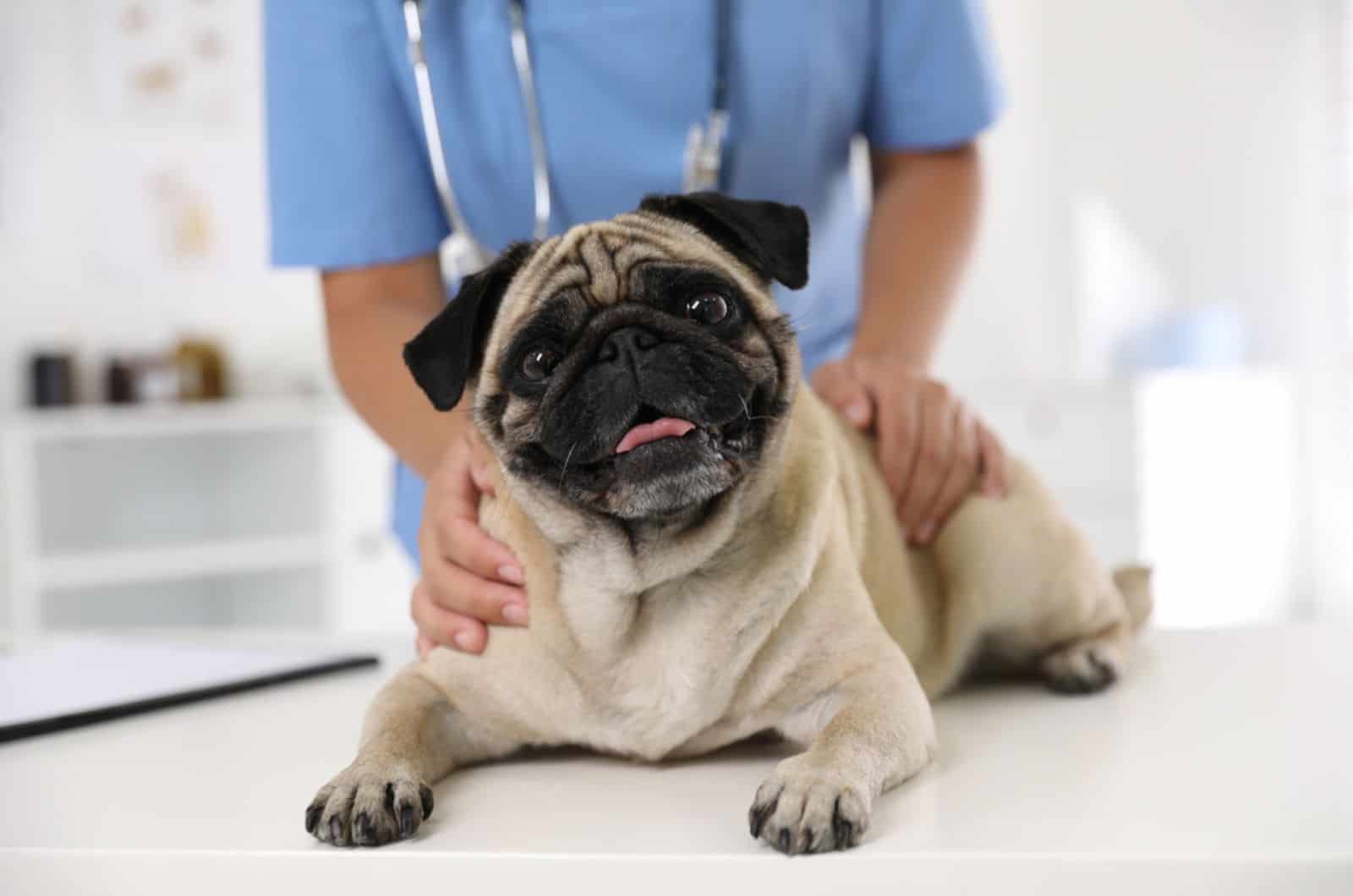
Numerous health problems can affect pugs, and a lot of them are the result of their brachycephalic conformations. They share those issues with some other breeds who have a similar head and body shape, for example, the Bulldogs.
Fortunately, your veterinarian can help you manage many of their potential health issues. Some of them can even be detected early on by using DNA tests.
But since this is an article about Pug growth, we want to focus on health issues that are related to weight, in particular. And you can’t talk about Pugs’ weight without mentioning their high risk of becoming overweight or even obese.
Overweight Pugs
Pugs have a tendency to put on excess weight. They are opportunistic eaters who munch on everything that comes their way and this increases their propensity for obesity.
Pugs could also get overweight if their diet is not controlled, if the food is of low quality, or if they are not active enough.
What To Do If Your Pug Is Overweight
If you are getting the feeling that your Pug is getting overweight, you should take it to the vet for a checkup.
The vet can rule out any potential medical conditions that could be causing your Pug’s weight gain, and from then on, you can try to control its weight by yourself.
If your Pug is healthy, you can help it lose weight by taking the following actions:
– Cut back on the serving sizes.
– Cut back on snacks and treats.
– Increase the level of physical activity.
– Make sure the food you are giving them is nutritional and of excellent quality.
– Make sure your puppy is not under any stress.
Underweight Pugs
Pugs don’t get underweight all that often, but it’s still good to know what causes it and what you can do to combat it.
The most frequent causes of being underweight in Pugs are various parasites, diabetes and other medical conditions, teeth problems, as well as a poor diet.
What To Do If Your Pug Is Underweight
Talking to a veterinarian should be your initial course of action. If your dog has a parasite or a serious ailment that you need to treat, you shouldn’t be trying at-home DIY cures.
There are a few at-home remedies you might try after your veterinarian has ruled out an underlying illness. You should start by switching to high-quality dog food. Pugs can be picky eaters, but high-quality dog food from a premium brand should work.
After that, you have to make sure to give them smaller meals, but more frequently. Before feeding your pug again, give it some time to digest the last meal. To speed up the process, you might add some nutritious weight-gain snacks to these meals.
Finally, make sure to give your pug a thorough workout. Although it may seem contradictory, exercise will aid in the development of muscles and boost hunger. Just be careful not to overwork it because that would be counterproductive.
How To Measure A Pug
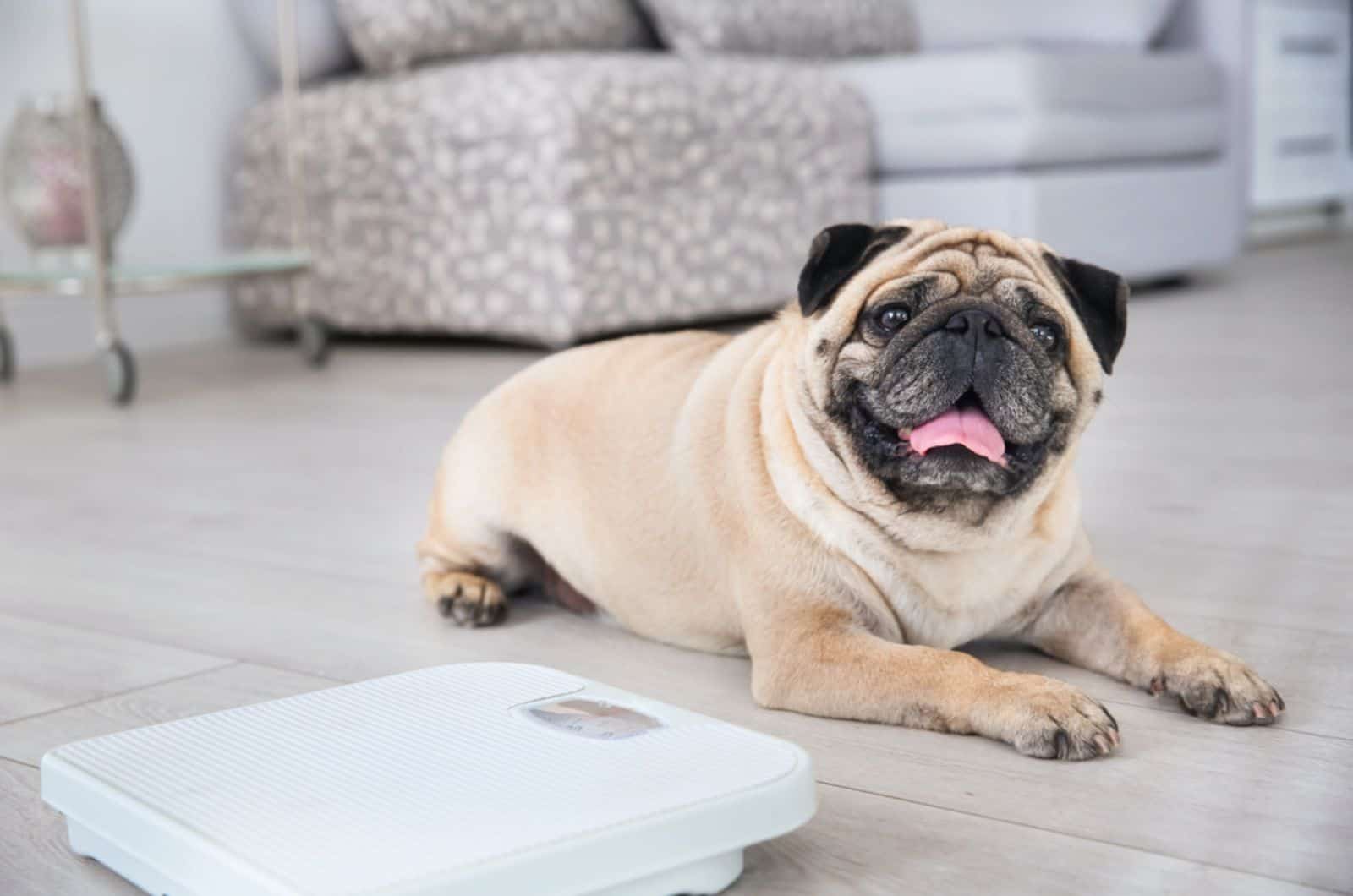
There are various possible measurements that you might want to take on your Pug. Its weight is perhaps the most important one, but there are others, as well. For example, you might want to know its neck and chest circumference in order to buy the best possible harness.
In the following section, we will explain how to perform some of the most common measurements on your Pug.
Measuring A Pug’s Weight
The standard recommendation for weighing your Pug is once every month until it turns six months of age. After that, you should weigh it once every six months.
You should weigh your Pug more frequently if they have any medical issues because some illnesses can result in weight shifts.
To weigh your Pug at home, you will need a bathroom scale. If your dog is calm and disciplined enough, you can just put it on the scale and note the reading.
However, if you can’t get it to stand still on the scale, then there is an alternative. Simply step on the scale yourself, while carrying your Pug, then note the reading.
Next, weigh yourself without the Pug by your side. Lastly, subtract the second weight from the first weight to determine the difference, and the result is your Pug’s weight.
Measuring A Pug’s Height
It can be helpful to know your Pug’s height for a number of different purposes. You could need it for your pet’s health records or to buy the right equipment, including dog crates, dog beds, etc.
Just keep in mind to measure a dog from the paws to the withers, not to the head.
The procedure is as follows:
1. Position your Pug directly against a wall or doorframe.
2. Locate the withers of your Pug.
3. Ensure that the dog’s withers are flat by running a carpenter’s level across them.
4. Use a pencil to make a mark on the wall or doorframe indicating the withers’ height.
5. Calculate how far the pencil mark is from the floor.
Pug’s Neck Size
Knowing your Pug’s neck size will help you choose a comfortable collar for it. Using just a soft measuring tape, you can measure your Pug’s neck size yourself at home.
Put two fingers between the Pug’s neck and the tape after wrapping it twice around the thickest section of the neck. Your Pug’s neck size will be used for the measurement.
Pugs typically have necks that range in size from 12 to 16 inches on average.
Pug Body Condition Score
The Body Condition Score (BCS) of a Pug reveals how much fat they have and whether or not they are an ideal weight. Two scales — either 1 to 5 or 1 to 9 — can be used to get the BCS.
A Pug’s optimal Body Condition Score should be 3/5 or 5/9, depending on the scale you choose.
This implies that while your Pug has a thin layer of fat covering its entire body, its ribs can easily be felt with the fingertips and its waistline and stomach tuck are both visible to the eye.
Your Pug’s BCS will be 9/9 or 5/9 if they are obese, and 1/9 or 1/5 if they are emaciated.
Why Do I Need A Pug Growth Chart?
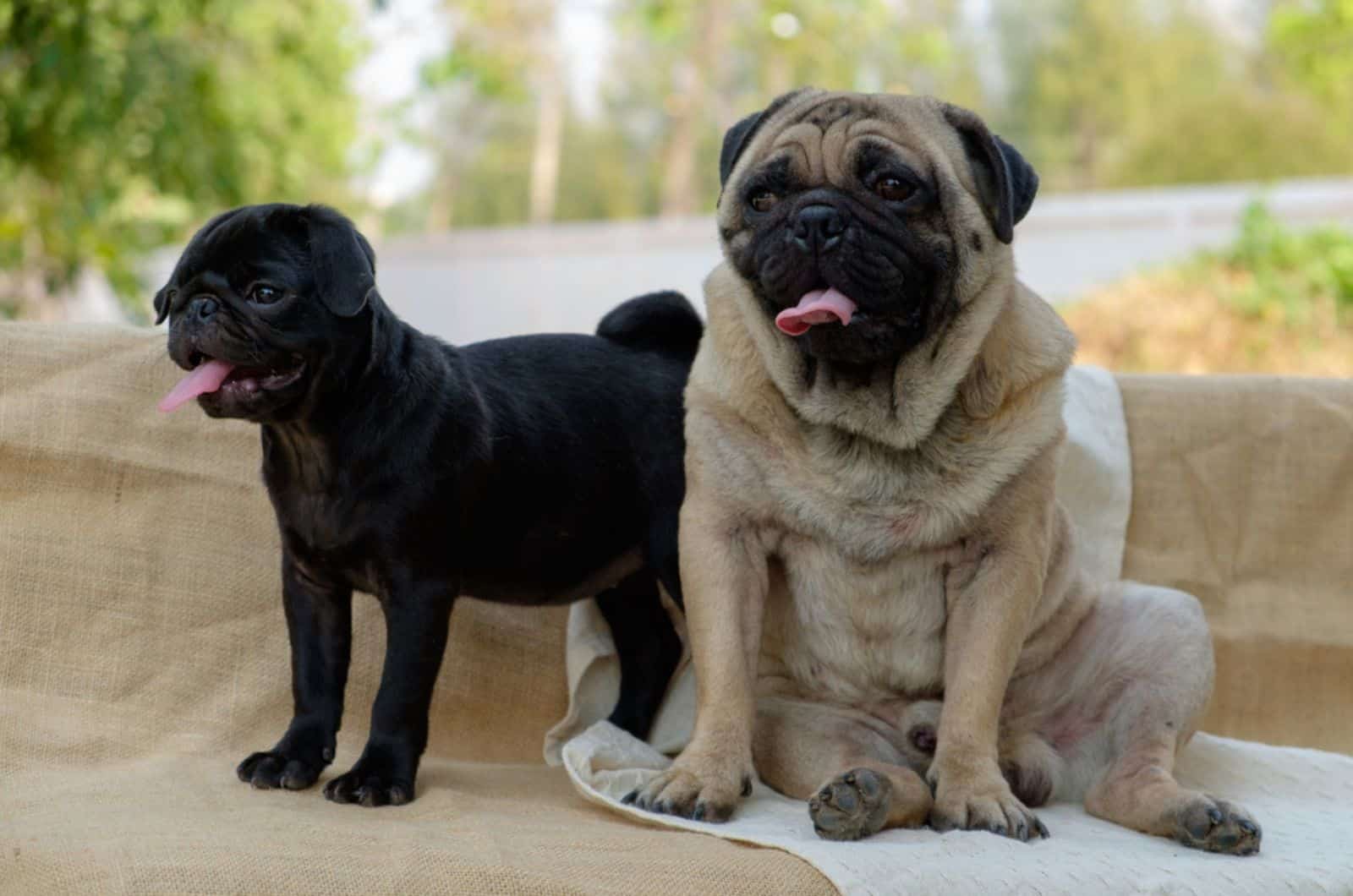
Observing a puppy’s growth during those crucial early months is a key facet of dog ownership. Pugs aren’t exactly big dogs, but they still need a lot of space to move around and feel comfortable in their environment.
You need to be able to predict their height and weight correctly so that you are able to account for this.
With the Pug growth chart, you will be able to monitor your puppy’s growth and make sure that its weight is increasing in the proper amounts by frequently weighing it and comparing it against the values in the chart.
Not to mention all the other factors that need your focus, including your diet, degree of exercise, training, etc. Knowing how big and heavy your Pug should be at a certain age will help you plan its diet, living space, as well as your budget.
Read next: How Much Do Pugs Cost: Everything You Need To Know!
Pug Growth FAQ
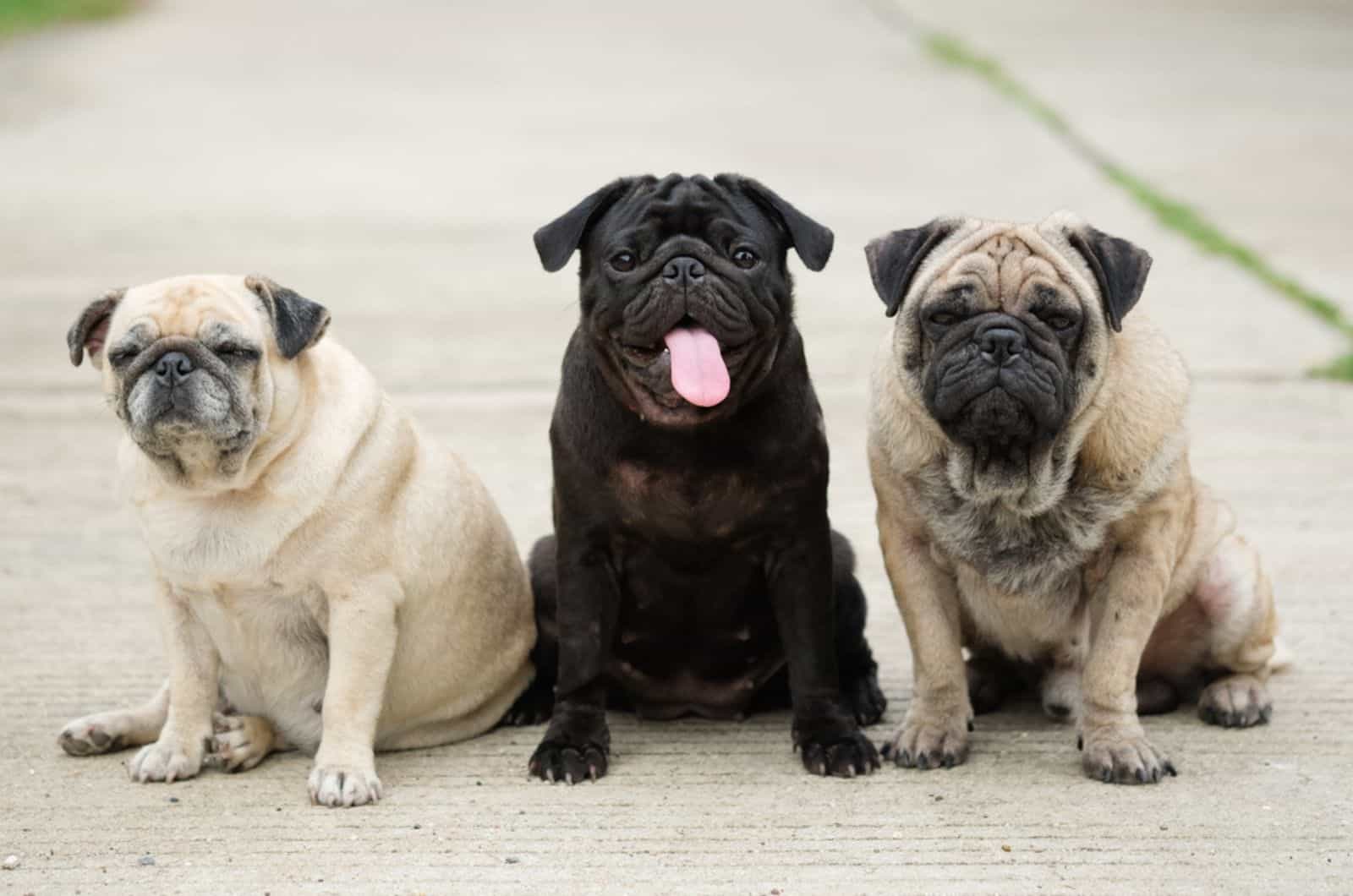
This Pug growth chart will undoubtedly be a helpful resource for you if you already own a Pug or are simply considering getting one.
By carefully adjusting your puppy’s nutrition and activity routine, you may use it to anticipate the growth of your puppy throughout its development and ensure that it stays within the healthy weight range.
Furthermore, some of the other details we have supplied will give you a fair indication of what to anticipate from a Pug puppy at different stages of development.
We haven’t yet addressed a number of concerns and inquiries, though. So, we made the decision to group them all together in a straightforward, understandable, and user-friendly FAQ area.
When Do Pugs Stop Growing?
Pugs grow to their full size more quickly than medium or large-sized dogs, like many small dog breeds.
Around nine months of age, pugs reach their adult size, though they may continue to gain a tiny bit of muscle until they are a year old.
How Big Do Pugs Get?
Pugs, although having a sturdy exteriors, belong to the toy category of dogs. They weigh between 14 and 18 pounds, and their height varies from 10 to 13 inches.
They are stocky, square dogs with thick limbs. Owing to their mastiff ancestry, pugs are the most robust of the toy breed.
How Does Spaying/Neutering Affect A Pug’s Growth?
There are several myths about how neutering or spaying a dog before it reaches adolescence may cause them to grow less quickly.
The truth is that early spaying and neutering of Pugs has both many advantages and many risks. According to some research, castrating and spaying dogs can extend their lives and perhaps prevent later-life issues.
Male castration lowers the risk of testicular and prostate cancer.
When Is The Ideal Time To Neuter Or Spay My Pug?
Veterinarians normally advise having your Pug spayed or neutered between the ages of four and nine months, though advice varies. That might seem like a pretty wide range, but that’s because it’s dependent on the dog’s gender.
Although there is no 100 percent surefire solution, it is frequently advised that you have your male Pug neutered after he has reached adolescence. This is believed to offer long-term health advantages in addition to preventing behavioral traits like aggressiveness and marking.
There is no one-size-fits-all recommendation for when to spay female Pugs. Some experts advise spaying before the first heat cycle (as early as five months), but others contend that doing so may raise the risk of mammary tumors.
For a unique viewpoint, we would always advise seeing your Pug’s veterinarian, because they will have the best knowledge of the context surrounding your particular dog.
What Is The Average Lifespan Of A Pug?
According to the American Kennel Club (AKC), the average life expectancy of a Pug is between 13 and 15 years.
Some Pugs exceed that, in fact, there have been Pugs that lived to be 20 years old. However, the vast majority will be around the lower end of that expectancy.
What Does A Pug Weigh At Birth?
Pugs are toy dogs who are tiny even when they are fully adult, so you can probably imagine how minuscule they are when they first arrive in the world.
Typically, a newborn Pug will weigh between 0.17 and 0.77 pounds (0.08 and 0.35 kg), which is about as much as an average apple.
Final Thoughts
The Pug growth chart is a really helpful tool to have if you own one of these little dogs. Their weight isn’t as unpredictable as it is in some large breeds, but it’s still good to know what to expect.
Knowing the dog’s size and weight beforehand will help you prepare for the experience. You can decide what accessories, food, and care are needed for the dog by knowing its size.
By comparing the figures from the Pug weight chart to your puppy’s actual weight, you can easily keep track of your Pug’s development at any moment.
You can also better focus your efforts on enhancing your Pug’s health by using the size chart. Your chances of successfully resolving health issues will increase if you find them early on.
Read Next: 9 Best Pug Breeders: How To Find A Breeder You Can Trust
